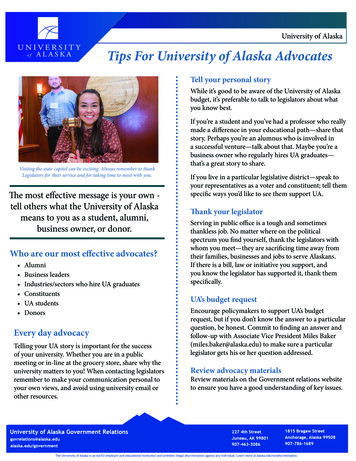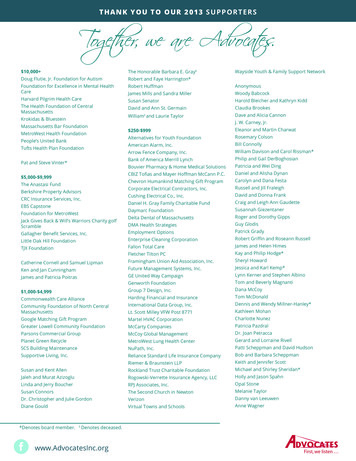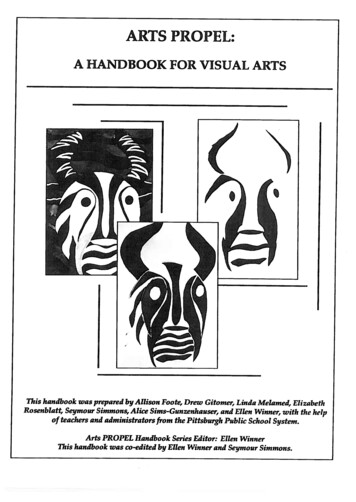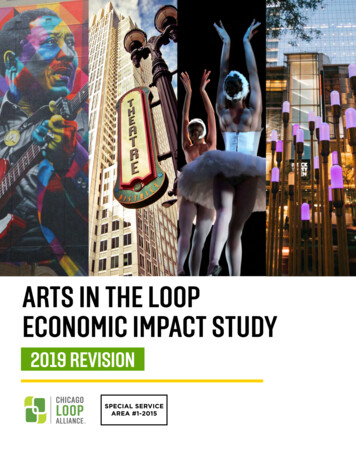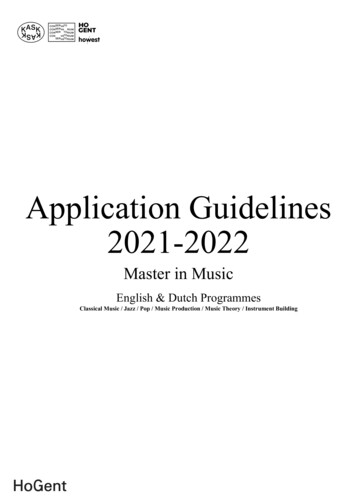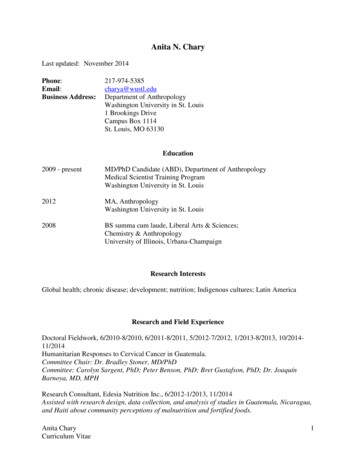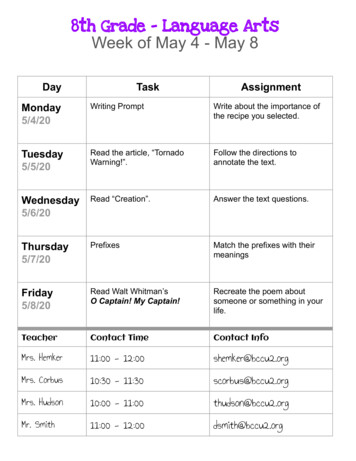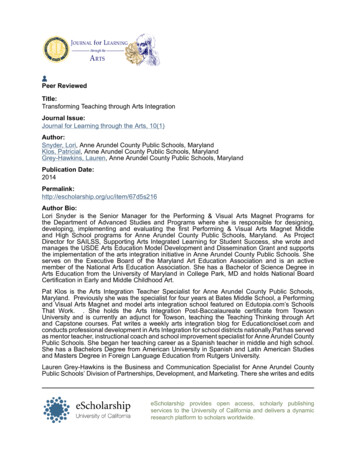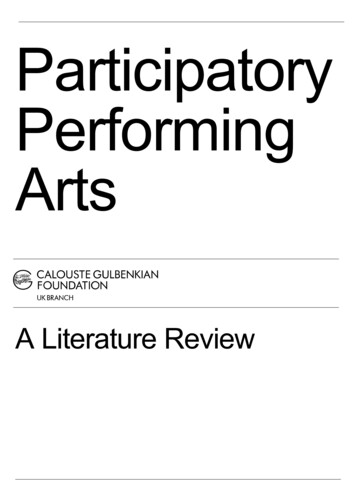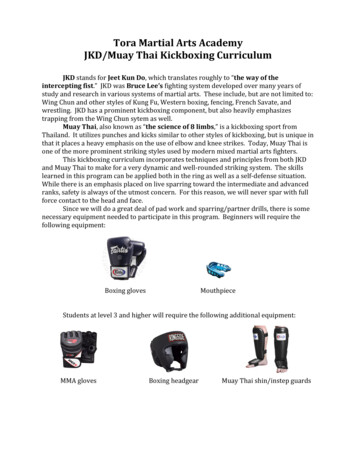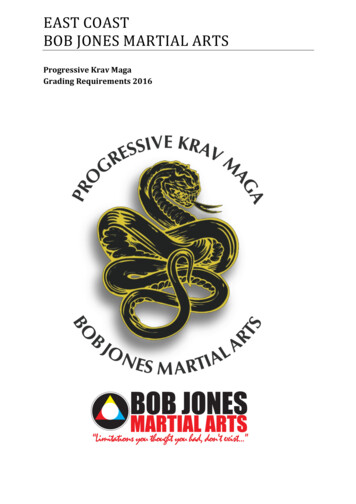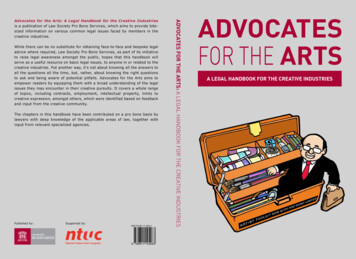
Transcription
While there can be no substitute for obtaining face-to-face and bespoke legaladvice where required, Law Society Pro Bono Services, as part of its initiativeto raise legal awareness amongst the public, hopes that this handbook willserve as a useful resource on basic legal issues, to anyone in or related to thecreative industries. Put another way, it’s not about knowing all the answers toall the questions all the time, but, rather, about knowing the right questionsto ask and being aware of potential pitfalls. Advocates for the Arts aims toempower readers by equipping them with a broad understanding of the legalissues they may encounter in their creative pursuits. It covers a whole rangeof topics, including contracts, employment, intellectual property, limits tocreative expression, amongst others, which were identified based on feedbackand input from the creative community.The chapters in this handbook have been contributed on a pro bono basis bylawyers with deep knowledge of the applicable areas of law, together withinput from relevant specialized agencies.Published by:Supported by:ISBN 978-981-11-4506-39 789811 145063Advocates for the Arts: A LEGAL HANDBOOK FOR THE CREATIVE INDUSTRIESAdvocates for the Arts: A Legal Handbook for the Creative Industriesis a publication of Law Society Pro Bono Services, which aims to provide bitesized information on various common legal issues faced by members in thecreative industries.Advocatesfor the ArtsA Legal Handbook for the Creative Industries
ADVOCATESFOR THE ARTSA LEGAL HANDBOOK FOR THE CREATIVE INDUSTRIES
Advocates for the ArtsCopyright 2018 Law Society Pro Bono ServicesDISCLAIMERThis booklet contains general information on the law andlegal matters, which is provided by volunteer lawyerswho are members of the Law Society of Singapore. Theinformation is provided as a public service by Law SocietyPro Bono Services (“LSPBS”). While the informationis derived from sources believed to be reliable andaccurate as at 2 January 2018, LSPBS does not makeany representation or warranty as to the accuracy of theinformation. LSPBS and its representatives also do notaccept any responsibility for errors or omissions in theinformation provided. The information provided is notlegal advice and should not be treated as an alternativeto seeking legal advice from your lawyer. The informationprovided in this booklet is not a definitive analysis of thesubject and professional legal advice should always betaken before any course of action is pursued.Views expressed by the contributors are strictly thepersonal views of the respective contributors and are notnecessarily those of LSPBS. Whilst every effort has beenmade to ensure that the information contained in thisbooklet is correct, the contributors, the editorial team, andLSPBS disclaim all liability and responsibility for any erroror omission in this publication, and in respect of anything,or the consequences thereof, done or omitted to be done byany person in reliance, whether wholly or partially, on thewhole or any part of the contents of this publication.Statutory instruments of the laws of Singapore referred toin this booklet can be found at https://sso.agc.gov.sg/.All rights reserved. No part of this publication may bereproduced, stored in any retrieval system, or transmitted,in any form or by any means, whether electronic orphysical, including photocopying and recording, without thewritten permission of the respective copyright holders.Published January 2018ISBN: 978-981-11-4506-3
ContentsForeword by Law Society Pro Bono Services5Foreword by National Trades Union Congress7Chapter 1: Introduction8Chapter 2: Employment Issues12Chapter 3: Contracts29Chapter 4: Dispute Resolution51Chapter 5: Insurance59Chapter 6: Law of Confidence/Non-disclosure Agreements69Chapter 7: Copyright Essentials76Chapter 8: Trademark Essentials90Chapter 9: Limits to Creative Expression110Chapter 10: Competition Law in Singapore130Chapter 11: Setting Up an Arts Business153Chapter 12: Seeking Legal Assistance176
Appendices189Sample Contract Clauses190Sample Intellectual Property Clauses196National Trades Union Congress200Infocomm Media Development Authority205DesignSingapore Council209Musicians Guild of Singapore210Screenwriters Association (Singapore)212The Singapore Association of Motion Picture Professionals215About Law Society Pro Bono Services217Acknowledgements218
Foreword by Law Society ProBono ServicesDear reader, you hold in your hand a slim book with a broad aim: it is alegal guide for those who make their living in the creative industry.Over the past few years, we in the Law Society of Singapore (the“Law Society”) have been meeting groups and individuals who playa part in producing music, literature, drama and art for all of us inSingapore. These people dedicate their lives to enriching the lives of allSingaporeans: they document our memories, they capture our moods,they define what it is to be Singaporean. Their ideas, spirit and skillinspire us, and make us proud to be part of this island.The creative process begins with the romance of conceiving an idea,and ends with the birth of an artistic work. The period of gestation maybe easy for some, and difficult for others. The reason? Sometimes, artistsdo not know what to expect. Or, they face people who do not behave asexpected. Time and time again, the people we met told us how they wereexploited. Freelancers were especially vulnerable to incidents of unfairtreatment. Gradually, we formed the strong impression of our mission.We needed to impart a better understanding of how the law protectsrights and promotes fair dealing. We needed to show how the legalsystem provides the creative community with a firm, safe scaffolding tosupport their endeavours.The Law Society resolved to set up the Advocates for the Arts: aninitiative to empower the creative community by informing them of theirlegal rights. We resolved to publish a handbook that would be useful toanyone making a living in the artistic community in Singapore.We then met numerous arts groups, administrators and businessesto learn about the needs of the creative sector. We approached publicspirited Singapore law firms, who enthusiastically agreed to contributeimportant chapters in the handbook. We told Colin Goh, the belovedcartoonist, entrepreneur and (yes!) lawyer, about our handbook, and hegenerously agreed to provide illustrations for us.5Foreword
Thanks to all these contributors, you now have in your hand aunique publication: a legal text for artists and those who give us art.It expresses legal concepts simply and clearly. It provides practicalinformation for the individual and the organisation, ranging frommaternity benefits and insurance to templates to enable the readerto put together a do-it-yourself contract. Our legal toolkit is madeavailable to you free of charge, as a service by the Law Society to thegreater society of Singapore.Mr Adrian TanVice PresidentThe Law Society of Singapore6Advocates for the Arts: A Legal Handbook for the Creative Industries
Foreword by National TradesUnion CongressThe “Advocates for the Arts” is an invaluable legal toolkit for individualsemployed in or seeking a career in the creative industries and it cannot bemore timely. The number of working people in the Arts, Entertainment andRecreation Industry has been increasing significantly over the years. As oflast year, the total number of working people in the Arts, Entertainment andRecreation Industry was 40,400; an increase of 3,400 from the previous year.With the Singapore government promoting the shift to a high-tech creativeeconomy in sectors such as animation, game design, industrial design, creativeagencies, sports and lifestyle, we can expect progressive increases in thenumber of working people embarking on a career in the creative industries.This emerging sector not only offers employment opportunities to theworking populace but also opportunities to entrepreneurs seeking to becomepioneers in their own right. Singapore’s robust Intellectual Property Frameworkhas provided a safe haven for producers, creators and intellectual propertyowners. It has also been critical in promoting and elevating the Cultural andCreative Industries.With the mechanisms in place advancing the creative industries, the onlylacuna is a concise, easily understandable and practical guide to the law for thecreative community and this legal toolkit more than adequately fills this space.The “Advocates for the Arts” is the handbook to go to for both employers andemployees. It enlightens as well as empowers the reader by capturing difficultlegal concepts such as intellectual property in a form that is palatable andeasily digested by the layman. A very useful and practical section is the one on“do-it-yourself” contract templates.I am delighted that the Law Society Pro Bono Services has published thismuch-needed legal handbook for the creative community. Its very essenceand appeal are in its simplicity and clarity which make reading the law andlegal concepts a painless and even an enjoyable experience.Mr Patrick Tay, BBMNTUC Assistant Secretary-GeneralMember of Parliament for West Coast GRC (Boon Lay)7Foreword
CHAPTER 1INTRODUCTIONThe creative sector is a vital part of Singapore society, enriching ourlives directly and even in ways that are intangible. For example, the artspromote Singapore as a dynamic and vibrant place to live and work,hence distinguishing it from other cities in the region. This has been oneof the most important aims of the Renaissance City Plan, an arts andcultural master plan launched in 2000 by the Government.The arts can also articulate our national narrative, and stimulatecritical debate and reflection, hence encouraging a reflective and engagedcitizenry. For example, Singapore’s Golden Jubilee year saw many playsthat explored local identity and history, thereby exploring and celebratingwhat it means to be Singaporean. Establishing Singapore as an “EndearingHome” is also one of the key thrusts of the Arts and Culture StrategicReview, which was initiated in 2010 and plots Singapore’s cultural roadmap up till 2025.Encouragingly, in economic terms, the cultural sector has been on anupward trajectory over the years. Total nominal value-added of the artsand cultural sector has increased steadily from about 922 million in 2003to almost 1.7 billion in 2014 (Ministry of Culture, Community and Youth.Singapore Culture Statistics. Singapore: Ministry of Culture, Communityand Youth; National Arts Council; National Library Board; NationalHeritage Board; People’s Association, 2016. Print, 76). As audiences,Singaporeans have also been more engaged in the arts. Nearly eight (8)in ten (10) Singaporeans or Singapore permanent residents went for ashow or an event, or visited a museum or gallery in 2015 (National ArtsCouncil. Population Survey On The Arts 2015. Singapore: National ArtsCouncil, 2016. Print, 12). To ensure that the creative industries continueto flourish and that arts consumption continues to grow, one importantstep is to protect the rights of artists and arts companies as well as theircreative content. This will enable creators to work more efficiently andwisely, better monetise their work, and concentrate on creating originaland compelling content.However, stories of plagiarism, payment failures and contractualdisputes are familiar in the industry. Freelance creative workers are an8Advocates for the Arts: A Legal Handbook for the Creative Industries
especially vulnerable group of practitioners. They provide a service on theirown account and at their own risk. As contract staff, they do not receivethe benefits of the employment laws, such as their Central Provident Fund(“CPF”), healthcare, leave benefits and retirement coverage. They arealso often unsure about what their rights are in the case of disputes.Over the years, there have been efforts to help freelance arts workersand arts organisations better understand the legal foundations of theirindustry and to better protect their interests. For example, National TradesUnion Congress (“NTUC”) has done its part to equip freelancers withknowledge of their rights and obligations through its e-pocket booklet,legal clinics, Workplace Advisory app and U-dialogue business workshops.A resource that provides insight into the legal underpinnings ofthe creative industry, is another step in this direction. The contents ofthis handbook can apply to both solo freelance practitioners and largercollectives or organisations in the arts, across theatre, dance, visual arts,literary arts, music, design and media.9Chapter 1: Introduction
By providing useful information, resources and experiences, thishandbook aims to serve the needs of freelance creators, organisations whoemploy these freelancers, as well as anyone who wants to gain a betterunderstanding of the legal principles governing the creative industries.There are currently no definite figures on the number of freelancersin the creative industry here, although there are broader statistics onself-employment.On February 7, 2017, in response to a parliamentary question on thesupport of freelancers from MP Desmond Choo, Manpower Minister LimSwee Say said there are some 180,000 primary freelancers in Singaporewho operate their business without hiring a paid worker (Ministry ofManpower, 2017). He added that primary freelancers make up 8 per centof employed residents here. What we know for sure is that the proportionof freelancers in the creative industries is significantly higher than thenational average. Freelancers make up almost half of the people working10Advocates for the Arts: A Legal Handbook for the Creative Industries
in Singapore’s arts and culture sector (National Arts Council, 2017),compared to just eight (8) per cent of the general workforce in Singapore.Therefore freelancing is a key feature of the arts landscape here.Freelancers, their clients, as well as larger arts organisations, will allbenefit from having a sourcebook of legal terms, principles and processesrelated to their industry. This will result in a creative class being moreaware of its legal rights and responsibilities, and making more confidentand informed decisions, which will in turn contribute to a mature anddynamic arts scene.11Chapter 1: Introduction
CHAPTER 2EMPLOYMENT ISSUES“Throw yourself into some work you believe inwith all your heart, live for it, die for it, and youwill find happiness that you had thought couldnever be yours.”– Dale CarnegieOverviewThis Chapter aims to provide individuals and employers with a broadoverview of employment law in Singapore. It will highlight the keyobligations owed by employers to their employees and address commonissues that employees may face in the course of their employment.What are the Sources of Employment Law?In Singapore, the key statutes governing employment law include:1. Employment Act (Cap. 91, 2009 Rev. Ed. Sing.);2. Employment of Foreign Manpower Act (Cap. 91A, 2009 Rev. Ed. Sing.);3. Central Provident Fund Act (Cap. 36, 2013 Rev. Ed. Sing.);4. Industrial Relations Act (Cap. 136, 2004 Rev. Ed. Sing.);5. Personal Data Protection Act 2012 (Act 26 of 2012);6. Retirement and Re-employment Act (Cap. 274A, 2012 Rev. Ed. Sing.);7. Trade Unions Act (Cap. 333, 2004 Rev. Ed. Sing.);8. Work Injury Compensation Act (Cap. 354, 2009 Rev. Ed. Sing.); and9. Workplace Safety and Health Act (Cap. 354A, 2009 Rev. Ed. Sing.).The Singapore Courts will also refer to Singapore case law, Englishcase law where Singapore legislation is similar to English statutes, Englishcommon law and equity, and Commonwealth case law from Malaysia, HongKong, Australia and New Zealand, especially where Singapore statutes arebased on or adapted from such jurisdictions.Tripartite GuidelinesThe Ministry of Manpower of Singapore (“MOM”), NTUC and SingaporeNational Employers Federation (“SNEF”) have also released various tripartiteguidelines governing Singapore employers and employees. While these12Advocates for the Arts: A Legal Handbook for the Creative Industries
guidelines do not have the force of law, they may eventually be adaptedto legislation. The tripartite guidelines also provide a basis for mediationand adjudication of employment disputes. The Commissioner for Labour andthe Industrial Arbitration Court will take reference from these guidelinesin settling employment claims and appeals. Some key examples of theseguidelines are:1. Tripartite Guidelines on Fair Employment Practices;12. Tripartite Advisory on Flexible Work Arrangements;23. Tripartite Guidelines on Managing Excess Manpower;3 and4. Tripartite Guidelines on the Re-employment of Older Employees.4What Is the Difference Between a Freelancer andan Employee?Contract for service vs Contract of serviceA preliminary question in determining your rights and obligations inthe course of your work, including whether you are covered under theEmployment Act, is whether you are an employee or an independentcontractor – otherwise known as a “freelancer”. A contract of servicedefines the employer-employee relationship and sets out certain termsand essential clauses, including key employment terms, which will becovered later in this Chapter.In contrast, a contract for service is between a client and an independentcontractor (or self-employed person), wherein the client engages theindependent contractor to provide certain services. This distinction isimportant as an independent contractor is not protected by the provisions ofthe Employment Act. Some key factors that would indicate an independentcontractor relationship as opposed to an employment relationship includeinstances where the person engaged to provide a service: is responsible for the production process, timing and method ofproduction; owns the tools and the equipment for the factors of production; is not provided with a working place and materials; carries on business on his or her own account instead of for anemployer;1.2.3.4.Tripartite Alliance for Fair & Progressive Employment Practices, Tripartite Guidelines On FairEmployment Practices. Singapore: Tripartite Alliance for Fair & Progressive EmploymentPractices, 2014. PrintTripartite Committee on Work-Life Strategy, Tripartite Guidelines on Flexible WorkArrangements. Singapore: Ministry of Manpower, 2014. PrintMinistry of Manpower, National Trades Union Congress, Singapore National EmployersFederation, Tripartite Guidelines on Managing Excess Manpower. Singapore: Singapore NationalEmployers Federation, 2009. PrintTripartite Alliance for Fair & Progressive Employment Practices, Tripartite Guidelines on theRe-employment of Older Employees. Singapore: Tripartite Alliance for Fair & ProgressiveEmployment Practices, 2017. Print13Chapter 2: Employment Issues
is liable for any risk of loss;is not bound by working hours and does not have leave benefits; oris paid upon completion of a project.There is no conclusive test to identify whether a contract is one “forservice” or “of service”, and an employer cannot rely on a contract labelled“for service” when in substance the contract is an employment contract.If an employer incorrectly characterises an individual as an independentcontractor when that individual is an employee, that employer may bepenalised.Under a contract for service, an individual who is self-employed is notcovered under the Employment Act and the Work Injury CompensationAct. Such an individual is not entitled to any statutory benefits such asovertime pay and rest day, and does not have mandatory employer CPFcontributions.Query: Can a production house not pay a writer if that writerdoes not follow a new schedule set by the production house?Answer: If the writer is an employee of the production houseand is covered under the Employment Act, the productionhouse is bound to pay the writer’s salary in accordance withthe employment contract. The terms of payment may inclu
AdvocAtes for the Arts Advoc A tes for the Arts: A L e GAL h ANDB oo K for the C re A t IV e INDUS tr I e S A LegAL hAndbook for the c
